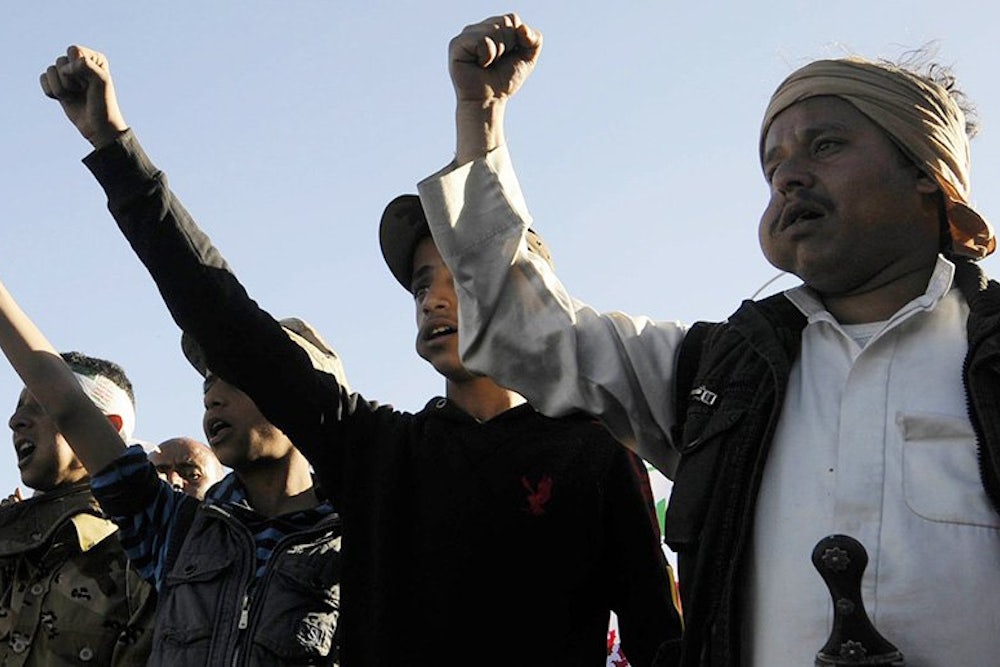Events in Yemen are moving fast: The U.S.-backed president, Abd Rabbuh Manṣūr Hadi, has been deposed by Shia rebels, after a “slow coup” that saw the Iran-backed Houthi militia take effective control of the capital, Sana'a, and besiege Hadi in the presidential palace.
The U.S. reacted to the removal of its ally by closing off the public parts of its embassy, while a drone strike against Al-Qaeda in the Arabian Penninsula (AQAP) reportedly killed three fighters. How the situation might resolve itself is anybody’s guess at the moment and must be keeping the Obama administration up at night.
In the wake of the Charlie Hebdo attack in Paris, it became clear that at least one of the attackers had a connection with AQAP. How much of a connection is unclear, but it is a reminder that AQAP is the only significant Al-Qaeda offshoot with transnational aspirations—especially an intent to attack the “far enemy” of the United States and its allies.
Some other highly significant groups, especially the Islamic State, may increasingly seek to take the war to the West, but these have little connection with the old Al-Qaeda, having clearly overshadowed it in recent years.
The Yemen connection, though, does raise the important question of whether U.S. policy towards AQAP in Yemen, often represented as something of a success story, is coming apart at the seams. This is in the wake of the removal of Hadi this week by Houthi rebels closely linked to the former president, Ali Abdullah Saleh, who was forced to stand down in the face of public pressure two years ago. The question of the U.S. position is even more salient given the resumption of U.S. drone strikes against AQAP earlier this week.
Complex and dangerous
The conflict in Yemen is extraordinarily complex, encompassing the Huthi rebellion, the involvement of Saudi Arabia and possibly Iran, the southern separatist movement, and also AQAP; all in a country with declining oil reserves, a serious water shortage, and a population of 25 million people, many of them in serious poverty.
Helen Lackner’s recent analysis is probably the best available and points to the failure of Western states to give sufficient aid to Hadi in his efforts to reconcile differences in a state marred by competing elites and factionalism. It is in the context of this failure that U.S. policy towards AQAP has to be discussed.
Only last September, Barack Obama had referred to the Yemen strategy as an appropriate example of how to “handle” Iraq and Syria. The approach would be one of training and equipping local security forces in sustained but low-level engagement, and, if the Yemen approach is repeated, relying heavily on reconnaissance and armed drones to weaken opponents.
The war in Iraq and Syria has now gone well beyond that. There have been more than 3,000 air strikes and drone attacks on more than 2,000 targets in less than six months—yet the Yemen policy was still viewed as one that could prove an effective model.
One core problem, though, is that the drone operations that were run both by the CIA and U.S. Joint Special Operations Command were highly dependent on intelligence on AQAP obtained by Yemeni government security and intelligence branches. Furthermore, they had the approval of the government in Sana’a so the Obama administration could claim legitimacy for its actions.
Remote control lost
With the ousting of the Hadi government, both elements are now in question—the intelligence will probably dry up and if some kind of reasonably stable government replaces Hadi, then a new regime could claim infringement of sovereignty. If that regime is Houthi-dominated, as seems likely, then while they have little liking for AQAP, they are equally opposed to U.S. policy, which they see as interference in the independence of the state.
This leaves the Obama administration with a major dilemma. For the past three years Obama has been deeply reluctant to engage in Yemen, Iraq, or Syria with significant deployment of ground troops. The preferred option has been termed “remote control” with greater reliance on armed drones, privatized military, special forces and other means—a rapidly developing military approach currently being researched by the Remote Control Project and the subject of a seminar at Leicester University next week.
So far, the U.S. approach in Yemen has been almost entirely dependent on drones and training local forces, but now the pressure is on to extend this to the direct use of Special Forces. This is already starting to happen in Iraq and Syria, with influential Congressional leaders such as chair of the Senate Armed Services Committee, John McCain, calling for a further expansion of Special Forces operations.
Following the events of the past week in Yemen, McCain and others now want a similar expansion there—and even while this pressure builds there is news of repeated violent engagements between Canadian special forces and Islamic State paramilitaries in Iraq.
When the air strikes against Islamic State started last August, Obama, Francois Hollande, David Cameron, Tony Abbott, Stephen Harper, and other Western leaders all said that that was as far as it would go. This is clearly not the case, and not only is mission creep already happening in Iraq and Syria, it now looks highly likely in Yemen as well.
This article was originally published on The Conversation. Read the original article.
